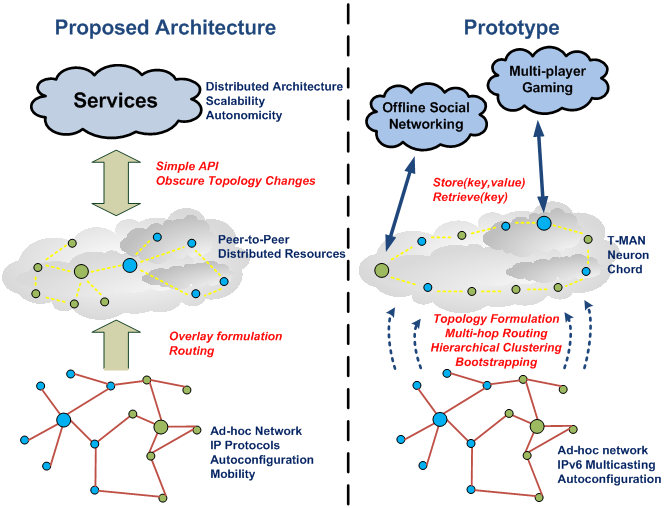ubi:chord Enabling Autonomic Communications in Ad-hoc Networks
UBITECH is working and developing technologies regarding autonomous computing, decentralized overlay networks, ad-hoc networking and routing, and overlay ad-hoc decentralized infrastructures for service provision. In particular, UBITECH R&D team has created an underlying autonomous computing infrastructure technology, called ubi:chord, through the full implementation of a mobile DHT that maintains a consistent hash table structure in an ad-hoc network, generating an ad-hoc overlay network. This practically means that each node entering the ad-hoc network (meaning that this node obtains a neighborhood relation with the nodes around it – through gossiping techniques) can register its own entries at the overlay, ad-hoc network and make its own queries over the data consistently stored there.
ubi:chord allows mobile terminals and devices (including sensors) to set up an ad-hoc network and enables end users to exchange multimedia content without the prerequisite of existing infrastructure. ubi:chord is based on a decentralized architecture and takes advantage of autonomic principles for the provision of services. ubi:chord is able to bootstrap the network without any predefined information, handles routing of packets, obscures any network topology changes and establishes an overlay network for distributed data sharing and retrieval. The users only need to activate a pre-installed software in their terminals in order to start interacting with others.
Technical Details
ubi:chord mobile devices autonomously indentify their neighbors. Using gossiping mechanisms, they are able to learn and maintain the network topology. In case of large-scale networks, probabilistic techniques for cluster formulation are applied, improving routing scalability and energy efficiency. An overlay network is established based on resources provided by (all) the nodes in the ad-hoc network. Application specific information is stored in the overlay network using Distributed Hash Tables (DHT) techniques.

Potential Application Areas
From our point of view, the technology already developed can be applied (as underlying infrastructure) to any application domain requires ad-hoc, autonomous and decentralized networking of sensors, devices, mobile equipment and cloud platforms (facilitating networking, coherency as well as semantically-enriched search and discovery capabilities). These technologies could be useful in the frame of future internet and network architectures initiatives, as well as in ad-hoc Cloud infrastructures, autonomous service provision, smart energy grids, vehicle-to-vehicle communications (VANETs), etc.
In particular, ubi:chord may lead to the provision of innovative services using heterogeneous mobile terminals. If necessary, ubi:chord terminals may be connected to the Internet directly or via gateways. An indicative set of applications or services is the following:
- Chatting: Users exchange messages (or files) without any need for central infrastructure or Internet (3G or wifi) connectivity.
- Social Networking: Off-line users exchange messages within the ad-hoc network. When online, any messages are uploaded to the appropriate site.
- Gaming: Users interact in a multi-player game in almost real time.
- Personalised Advertising: Users publish profiles and targeted advertisements are automatically forwarded as they join networks within shopping centres.
- Area Security Control: Sensors (or cameras) autonomously recognize their neighbours. If events are identified, predefined actions are initiated.


